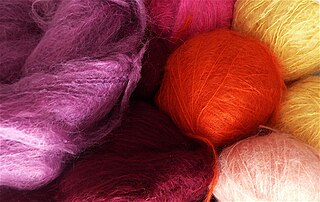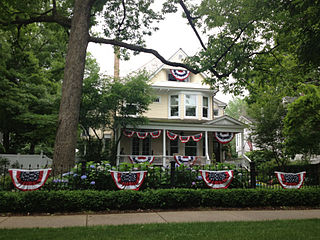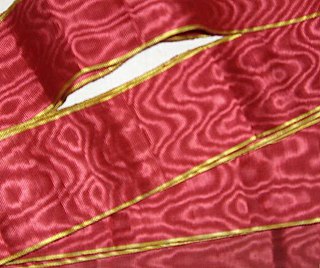Related Research Articles

Wool is the textile fiber obtained from sheep and other mammals, especially goats, rabbits, and camelids. The term may also refer to inorganic materials, such as mineral wool and glass wool, that have some properties similar to animal wool.

Textile is an umbrella term that includes various fiber-based materials, including fibers, yarns, filaments, threads, different fabric types, etc. At first, the word "textiles" only referred to woven fabrics. However, weaving is not the only manufacturing method, and many other methods were later developed to form textile structures based on their intended use. Knitting and non-woven are other popular types of fabric manufacturing. In the contemporary world, textiles satisfy the material needs for versatile applications, from simple daily clothing to bulletproof jackets, spacesuits, and doctor's gowns.

Yarn is a long continuous length of interlocked fibres, used in sewing, crocheting, knitting, weaving, embroidery, ropemaking, and the production of textiles. Thread is a type of yarn intended for sewing by hand or machine. Modern manufactured sewing threads may be finished with wax or other lubricants to withstand the stresses involved in sewing. Embroidery threads are yarns specifically designed for needlework. Yarn can be made of a number of natural or synthetic materials, and comes in a variety of colors and thicknesses. Although yarn may be dyed different colours, most yarns are solid coloured with a uniform hue.

Mohair is a fabric or yarn made from the hair of the Angora goat. Both durable and resilient, mohair is lustrous with high sheen, and is often blended to add these qualities to a textile. Mohair takes dye exceptionally well. It feels warm in winter due to excellent insulating properties, while moisture-wicking keeps it cool in summer. It is durable, naturally elastic, flame-resistant and crease-resistant. It is considered a luxury fiber, like cashmere, alpaca, angora, and silk, but is more expensive than most sheep's wool.

Poplin, also called tabinet, is a fine wool, cotton or silk fabric that has a vertical warp and a horizontal weft. Nowadays, the name refers to a strong material in a plain weave of any fiber or blend, with crosswise ribs that typically give a corded surface.

Cashmere wool, usually simply known as cashmere, is a fiber obtained from cashmere goats, pashmina goats, and some other breeds of goat. It has been used to make yarn, textiles and clothing for hundreds of years. Cashmere is closely associated with the Kashmir shawl, the word "cashmere" deriving from an anglicization of Kashmir, when the Kashmir shawl reached Europe in the 19th century. Both the soft undercoat and the guard hairs may be used; the softer hair is reserved for textiles, while the coarse guard hair is used for brushes and other non-apparel purposes. Cashmere is a hygroscopic fiber which essentially means that it absorbs water from the air. This helps regulate the body in both warm and cool temperatures by absorbing and releasing moisture based on the surrounding environment.

Crêpe, also spelled crepe or crape, is a silk, wool, or synthetic fiber fabric with a distinctively crisp and crimped appearance. The term "crape" typically refers to a form of the fabric associated specifically with mourning. Crêpe was also historically called "crespe" or "crisp".

Broadcloth is a dense, plain woven cloth, historically made of wool. The defining characteristic of broadcloth is not its finished width but the fact that it was woven much wider and then heavily milled in order to shrink it to the required width. The effect of the milling process is to draw the yarns much closer together than could be achieved in the loom and allow the individual fibres of the wool to bind together in a felting process, which results in a dense, blind face cloth with a stiff drape which is highly weather-resistant, hard wearing and capable of taking a cut edge without the need for being hemmed.
The manufacture of textiles is one of the oldest of human technologies. To make textiles, the first requirement is a source of fiber from which a yarn can be made, primarily by spinning. The yarn is processed by knitting or weaving, which turns it into cloth. The machine used for weaving is the loom. For decoration, the process of colouring yarn or the finished material is dyeing. For more information of the various steps, see textile manufacturing.
The United Nations General Assembly declared 2009 as the International Year of Natural Fibres (IYNF), as well as the International Year of Astronomy.

Animal fibers are natural fibers that consist largely of certain proteins. Examples include silk, hair/fur and feathers. The animal fibers used most commonly both in the manufacturing world as well as by the hand spinners are wool from domestic sheep and silk. Also very popular are alpaca fiber and mohair from Angora goats. Unusual fibers such as Angora wool from rabbits and Chiengora from dogs also exist, but are rarely used for mass production.
Chiengora, also called "dog wool," is yarn or wool spun from dog hair. The word is a portmanteau of chien and angora and was coined by an American spinner, Annette Klick. Dog hair is up to 80% warmer than wool and is not elastic.
Druggett or drugget is "a coarse woollen fabric felted or woven, self-coloured or printed one side". Jonathan Swift refers to being "in druggets drest, of thirteen pence a yard".

Bunting refers to decorative flags, wide streamers, draperies made of fabric, or of plastic, paper or cardboard in imitation of fabric. Bunting is also a collection of flags, and the fabric used to make flags. The fabric was originally a specific type of lightweight worsted wool fabric, but can also be cotton.

Moire, less often moiré, is a textile with a wavy (watered) appearance produced mainly from silk, but also wool, cotton and rayon. The watered appearance is usually created by the finishing technique called calendering. Moiré effects are also achieved by certain weaves, such as varying the tension in the warp and weft of the weave. Silk treated in this way is sometimes called watered silk.
A blend is a mixture of two or more fibers. In yarn spinning, different compositions, lengths, diameters, or colors may be combined to create a blend. Blended textiles are fabrics or yarns produced with a combination of two or more types of different fibers, or yarns to obtain desired traits and aesthetics. Blending is possible at various stages of textile manufacturing. The term, blend, refers to spun fibers or a fabric composed of such fibers. There are several synonymous terms: a combination yarn is made up of two strands of different fibers twisted together to form a ply; a mixture or mixed cloth refers to blended cloths in which different types of yarns are used in warp and weft sides.
Delaine was a kind of mixed cloth with cotton warp and wool in the weft. Delaines have many variations such as made of undyed yarns, and also printed or piece dyed. Delaine was a type of cloth used to manufacture women's dresses that was traded in the nineteenth century under many names to suit importers and traders. Moreover, it appeared that the plaintiffs' goods differed from delaines in various other respects.
Barak or Barag (برگ), also called barrak or burruk, is a kind of soft, thick and durable fabric that is woven by hand from goat and sheep wool or camel hair in Khorasan. Barak is a soft and strong textile, and is mainly used for sewing men's clothes. The warmth of the very thick and soft fabric is reputed to reduce muscle and joint pains. In the past, most of the dervishes made clothes and hats from barak, and later, with the improvement of its quality, kings and rulers also wore barak clothes.
The Wool Products Labeling Act is a U.S. regulation enacted in 1939, which makes provisions for the accurate labeling of products containing wool fibers. The purpose of this act is to promote transparency and safeguard consumers and stakeholders in the wool industry from deceptive practices and false information regarding the composition of wool products in the market.
References
- ↑ Webster's Revised Unabridged Dictionary. 1913.
- 1 2 "Camlet". Oxford English Dictionary. Oxford University Press. 2nd edition. 1989.
- 1 2 3 4 5
 This article incorporates text from a publication now in the public domain : Chambers, Ephraim, ed. (1728). "Camelot, or Camlet". Cyclopædia, or an Universal Dictionary of Arts and Sciences (1st ed.). James and John Knapton, et al.
This article incorporates text from a publication now in the public domain : Chambers, Ephraim, ed. (1728). "Camelot, or Camlet". Cyclopædia, or an Universal Dictionary of Arts and Sciences (1st ed.). James and John Knapton, et al. - ↑ Lebeau, Caroline (1994). Fabrics : the decorative art of textiles. Internet Archive. London : Thames and Hudson. pp. 204, 205. ISBN 978-0-500-01631-2.
- ↑ Treasury, United States Department of the (1892). Treasury Decisions Under Customs and Other Laws. U.S. Government Printing Office. p. 599.
- ↑ Dooley, William Henry (1914). Textiles For Commercial, Industrial and Domestic Arts Schools; Also Adapted to Those Engaged in Wholesale and Retail Dry Goods, Wool, Cotton and Dressmaker's Trades. Library of Alexandria. ISBN 978-1-4655-4393-6.
- ↑ Chambers's encyclopaedia: a dictionary of universal knowledge, Volume 1. J.B. Lippincott & Co. 1888. p. 263.